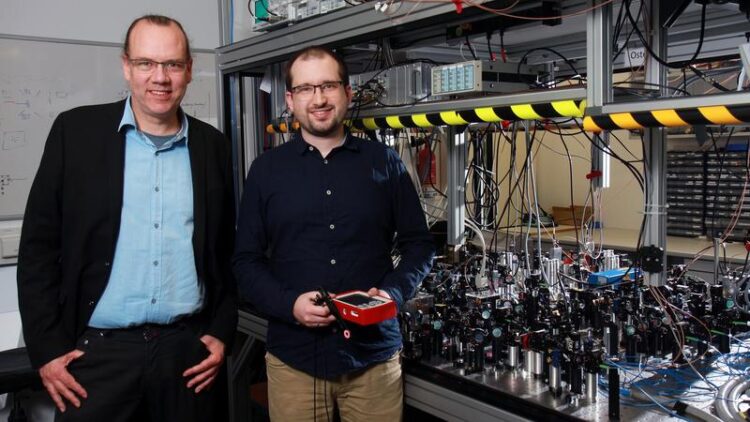Physicists create giant trilobite molecules

The team led by Professor Herwig Ott (left) and Max Althön produced the trilobite molecules.
Credit: RPTU, Koziel
Kaiserslautern physicists in the team of Professor Dr. Herwig Ott have succeeded for the first time in directly observing pure trilobite Rydberg molecules. Particularly interesting is that these molecules have a very peculiar shape, which is reminiscent of trilobite fossils. At the same time, they have the largest electric dipole moments of any molecule known so far. The researchers used a dedicated apparatus, which is capable to prepare these fragile molecules at ultralow temperatures. The results are important to understand the chemical binding mechanisms of them, which is distinct from all other chemical bonds. The study was published in the renowned journal “Nature Communications”.
For their experiment, the physicists used a cloud of rubidium atoms that was cooled down in an ultra-high vacuum to about 100 microkelvin – 0.0001 degrees above absolute zero. Subsequently, they excited some of these atoms into a so-called Rydberg state using lasers. “In this process, the outermost electron in each case is brought into far-away orbits around the atomic body”, explains Professor Herwig Ott, who researches ultracold quantum gases and quantum atom optics at University of Kaiserslautern-Landau. “The orbital radius of the electron can be more than one micrometer, making the electron cloud larger than a small bacterium.” Such highly excited atoms are also formed in interstellar space and are chemically extremely reactive.
If a ground state atom is now located within this giant Rydberg atom, a molecule is formed. While standard chemical bonds are either covalent, ionic, metallic or of dipolar nature, the trilobite molecules are bound by a completely different mechanism. “It is the quantum mechanical scattering of the Rydberg electron from the ground state atom, which sticks the two together” says Max Althön, who is first author of the study. Althön explains further: “Imagine the electron rapidly orbiting around the nucleus. On each round trip, it collides with the ground state atom. In contrast to our intuition, quantum mechanics teaches us that these collisions lead to an effective attraction between the electron and the ground state atom.”
The properties of these molecules are amazing: Due to the wave nature of the electron, the multiple collisions lead to an interference pattern which looks like a trilobite. Moreover, the bond length of the molecule is as large as the Rydberg orbit – way bigger than any other diatomic molecule. And because the electron is so strongly attracted by the ground state atom, the permanent electric dipole moment is extremely large: more than 1700 Debye.
In order to observe these molecules, the scientists have developed a dedicated vacuum apparatus. It allows for preparing ultracold atoms via laser cooling and subsequent spectroscopic detection of the molecules. The results help to understand fundamental binding mechanisms between ground state atoms and Rydberg atoms, which have recently become also a promising platform for quantum computing applications. The discovery of the researchers complements the understanding of Rydberg systems, which can be exotic and useful at the same time.
Research on this study took place within the priority programme “Giant Interactions in Rydberg Systems”, which is funded by the German Research Foundation. This research was carried out in the OPTIMAS profile area (Landesforschungszentrum für Optik und Materialwissenschaften – State Research Centre for Optics and Materials Sciences), which has been funded as part of the state’s research initiative since 2008.
The results of the measurements and a description of the experimental setup have been published in the renowned journal Nature Communications: “Exploring the vibrational series of pure trilobite Rydberg molecules”; Max Althön, Markus Exner, Richard Blättner & Herwig Ott
https://www.nature.com/articles/s41467-023-43818-7
DOI: https://doi.org/10.1038/ s41467-023-43818-7
Questions can be directed to:
Prof. Dr Herwig Ott
Ultracold quantum gases and quantum atom optics
University of Kaiserslautern-Landau
Phone: +49 0631 205-2817
E-mail: herwig.ott@rptu.de
Wissenschaftliche Ansprechpartner:
Prof. Dr Herwig Ott
Ultracold quantum gases and quantum atom optics
University of Kaiserslautern-Landau
Phone: +49 0631 205-2817
E-mail: herwig.ott@rptu.de
Originalpublikation:
Nature Communications: “Exploring the vibrational series of pure trilobite Rydberg molecules”; Max Althön, Markus Exner, Richard Blättner & Herwig Ott
https://www.nature.com/articles/s41467-023-43818-7
DOI: https://doi.org/10.1038/ s41467-023-43818-7
Media Contact
All latest news from the category: Physics and Astronomy
This area deals with the fundamental laws and building blocks of nature and how they interact, the properties and the behavior of matter, and research into space and time and their structures.
innovations-report provides in-depth reports and articles on subjects such as astrophysics, laser technologies, nuclear, quantum, particle and solid-state physics, nanotechnologies, planetary research and findings (Mars, Venus) and developments related to the Hubble Telescope.
Newest articles

Innovative 3D printed scaffolds offer new hope for bone healing
Researchers at the Institute for Bioengineering of Catalonia have developed novel 3D printed PLA-CaP scaffolds that promote blood vessel formation, ensuring better healing and regeneration of bone tissue. Bone is…

The surprising role of gut infection in Alzheimer’s disease
ASU- and Banner Alzheimer’s Institute-led study implicates link between a common virus and the disease, which travels from the gut to the brain and may be a target for antiviral…

Molecular gardening: New enzymes discovered for protein modification pruning
How deubiquitinases USP53 and USP54 cleave long polyubiquitin chains and how the former is linked to liver disease in children. Deubiquitinases (DUBs) are enzymes used by cells to trim protein…


